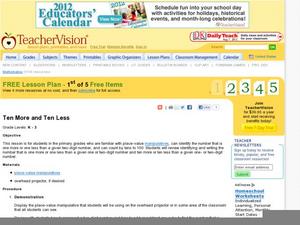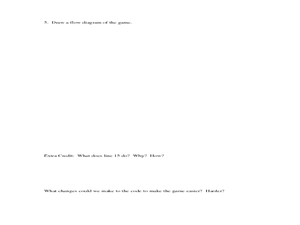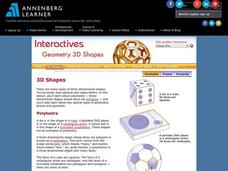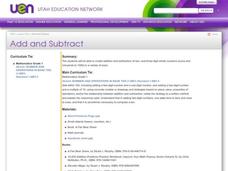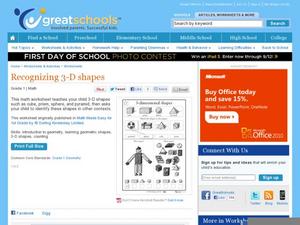Curated OER
Patterns
Students explore simple patterns. In this mathematical thinking geometry lesson plan, students repeat clapping and snapping patterns, and determine what comes next in sound and movement patterns. Students recite "Hey, Diddle, Diddle,"...
Curated OER
Decomposition, Numbers, and Subtraction
Wonderful for visual learners, this presentation provides images of 10's and 1's cubes, to reinforce the concept of subtraction. Learners practice along with the teacher as 10's and 1's cubes are scratched off.
Curated OER
Subtraction Practice: Less than 10
Mathematicians practice subtracting numbers less than ten. The instructional activity provides 25 practice opportunities to hone their skills. Answer key is provided. Number lines or unit cubes could scaffold the practice.
Math Salamanders Ltd.
Missing Subtraction facts to 12 sheet 1
Pupils subtract numbers one through 12 and complete missing addend problems. This worksheet includes a helpful number line and 20 problems to complete. Tip: Hand out unifix cubes or chips to help tactile learners solve each problem.
Curated OER
Geometric Shapes: Which Item?
Which item is shaped like a cone? Give students a chance to compare shapes, determining which item represents the prompted shape or figure (and which don't). Through 4 multiple-choice questions, scholars identify a cone, a cube, a...
Curated OER
Ten More and Ten Less
Get learners to analyze two-digit numbers based on place value, and use manipulatives to add and subtract both 1 and 10. A place value chart is available, and you can project it during guided practice. Through visualizing numbers,...
Curated OER
Nets
In this cube worksheet, students work with nets of a cube and determine which net makes an cube. Students answer 7 questions.
Curated OER
Graph the Dots
In this beginning graphing instructional activity, students roll two dot cubes of one color and two of another color. Students count the dots for each color and record the data on the graph.
Curated OER
Cube Count
In this cube counting worksheet, middle schoolers solve 5 word problems that refer to the illustration of a stack of cubes. First, they determine how many cubes would be needed to make four steps, then seven and eight steps. Students...
Curated OER
Surface Area and Volume of a Cube
Students explore finding the surface area and volume of cubes and cylinders. They construct similar three-dimensional figures from a two-dimensional drawing. Students derive the formula for volume and surface area through examination...
Curated OER
The Calendar Cube Problem
In this calendar cube problem, students use cubes to spell months and digits of the year. They use five cubes to display 366 days correctly. This one-page worksheet contains 1 problem. The answer is found at the bottom of the page.
Curated OER
Number Cube (Blank)
In this number cube worksheet, students use the blank number cube pattern for any math purpose. Students write the numbers from 1-6 in the squares, cut out the pattern and paste or tape the cube together.
Curated OER
Unit 22: Volume
In this volume instructional activity, students determine the volume of rectangular prisms. Students examine diagrams, tables and short story problems to determine information needed to find the volume. This ten-page instructional...
Curated OER
TI Math, Games
Students solve problems using technology. In this algebra lesson, students apply flow diagrams and computer codes to solve problems. They use the TI to view the graphs.
Curated OER
Fruity Math
Learners solve one step linear equations. In this algebra lesson, students manipulate their variables and numbers to answer each problem. They make sure the equations stay balanced at all times.
Curated OER
Math 5 - Act. 14: Patterns with Decimals
Fifth graders work together to display sequence card in the correct pattern. They investigate and discover patterns.
Mathematics Vision Project
Module 5: Modeling with Geometry
Solids come in many shapes and sizes. Using geometry, scholars create two-dimensional cross-sections of various three-dimensional objects. They develop the lesson further by finding the volume of solids. The module then shifts to finding...
Curated OER
Recognizing 3D Shapes, Part 3
Do your first graders know the difference between cones and cylinders? Use this handy activity to help youngsters learn geometric shapes. With prisms, spheres, and pyramids, among others, this resource prompts pupils to identify each...
University of Utah
Rational and Irrational Numbers
Conquer any irrational fears you might have of irrational numbers. As class members investigate how to represent numbers geometrically, they learn about rational and irrational numbers, including approximating and ordering rational...
Annenberg Foundation
Geometry 3D Shapes: 3D Shapes
Explore vocabulary related to three-dimensional shapes. An instructional website describes the characteristics of different geometric solids. Learners can use an interactive component to view nets, faces, vertices, and edges of common...
Curated OER
Add and Subtract
Like the cubs in A Fair Bear to Share, your 2nd grade class will practice adding and subtracting double-digit numbers by grouping, regrouping, and sorting a collection of objects. This requires many resources, but it is well worth the...
PBS
Arguing over Area
With the help of the Area Officers and Perimeter Patrol, you learners will develop a better understanding of area and its relationship to perimeter. First, they view a video clip from Cyberchase, and then they visit a website to test...
Curated OER
3-Dimensional Shapes
Where is the vertex? Each of these three-dimensional figures is drawn so learners can see all sides and corners. They examine an example before trying six on their own. Some of these will be tricky, so be sure kids have covered this...
Curated OER
Write the 3-D Shape's Name, Part 2
Geometry can be fun when you know the shapes! Twelve pictures of geometric shapes, including cones, pyramids, and spheres, prompt first graders to write the name of each shape in the space provided. Use the activity as a quiz or homework...







